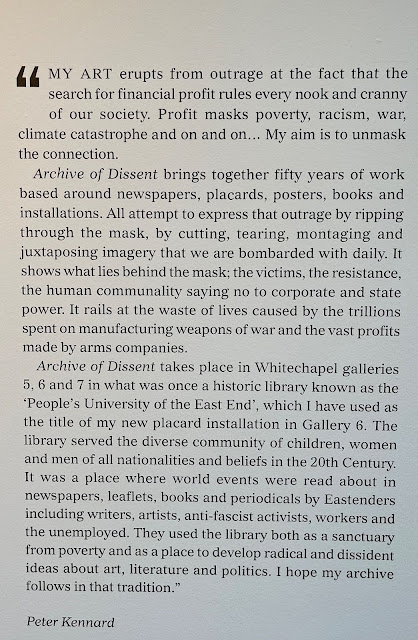A fascinating Derek Jarman talk and film at London's Farsight Gallery last month, featuring a 1984 LWT (London Weekend TV) documentary from the series 'South of Watford' about Jarman's life in London. It includes lots of great footage including Jarman on a boat going down the Thames pointing out the site of the warehouses he lived and worked in during the 1970s, including on the South Bank at Upper Ground, at13 Bankside (St Magnus warehouse and at Butlers Wharf by Tower Bridge where he moved in 1973. There is a scene too of him going through the gates of the latter on a building where there is now a plaque to remember him. As mentioned in the film, Ken Russell visited him on the South Bank and invited him to design sets for his film 'The Devils' - the start of Jarman's involvement in the film industry.
The film was directed by Jarman's assistant John Scarlett-Davis, who introduced it and told some very entertaining stories, including about filming a scene of Sebastiene at Andrew Logan's warehouse space with Lindsay Kemp also at Butlers Wharf. He recalled that at Jarman's Butlers Wharf studio the toilet was set up on a stage. Some people who were happy to take part in orgiastic parties apparently drew the line at going to the loo in front of everybody and a curtain was eventually put around it! Jarman and others had to move out of Butlers Wharf after a fire, one of a number in the area that some have observed were conveniently timed for property developers. Scarlett-Davis remembers being dressed up in the Blitz nightclub when news of the fire came through.
Scarlett-Davis helped Jarman with his film and pop video work, including Marianne Faithfull's Broken English, and made many videos in his own right including for some of my favourite songs from that period such as This Mortal Coil's Song to the Siren, Cocteau Twins 'Pearly dewdrops drops' and Scritti Politti's 'The Word Girl' and 'Wood Beez' (featuring dancer Michael Clark).
Scarlett-Davis talked a bit about the connection between Jarman, William Burroughs and Throbbing Gristle/Psychic TV, with the latter's Genesis P. Orridge featuring briefly int he LWT film. I was interested to hear that Scarlett-Davis and others had lived in another warehouse in Clink Street that later became a famous early acid house venue and later still a prison museum. John remembers Peter Christopherson (Throbbing Gristle/Coil) attending parties in the warehouse there. Coil later (1998) recorded their album Astral Disaster at an underground studio in Clink Street.
 |
| Derek Jarman, William Burroughs, Marc Almond, Psychic TV and others took part in 'The Final Academy' event in Heaven, 1983. |
The event was linked to the exhibition 'Derek Jarman: from Soho to the Fifth Continent' by Jane Palm-Gold at the Farsight Gallery which is at 4 Flitcroft St next to St Giles Church. The exhibition featured photos of Derek at Dungeness by Derek Ridgers as well as Jane's paintings featuring episodes from his life, particularly in the St Giles/Soho area where Jarman lived in a flat in Phoenix House from 1979.
Jane did a great job not just in bringing together the exhibition but in bringing together some of the people who were part of Jarman's life and creative work in London. The audience at the film show including Simon Fisher Turner (who composed music for several Jarman films), Jenny Runacre (who played the Queen in Jubilee) and several people who like Scarlett-Davis himself were naked Roman extras in Sebastiene. The event was hosted by Sean McLusky from Farsight Gallery, once promoter of legendary London clubs like Club UK and the Leisure Lounge as well as sometime drummer with JoBoxers.
John Scarlett-Davis should definitely write a book. He also has some very funny stories about working in the film/TV industry including sitting in the canteen in Elstree between Jack Nicholson and Molly Sugden when he was working on both 'The Shining' and TV sitcom 'Are you being served?'.
 |
| Jane Palm-Gold's painting of the 1993 OutRage Queer Carnival in Soho 1993, which was opened by Jarman and also featured the Sisters of Perpetual Indulgence |







.JPEG)

















.JPEG)


.jpg)


